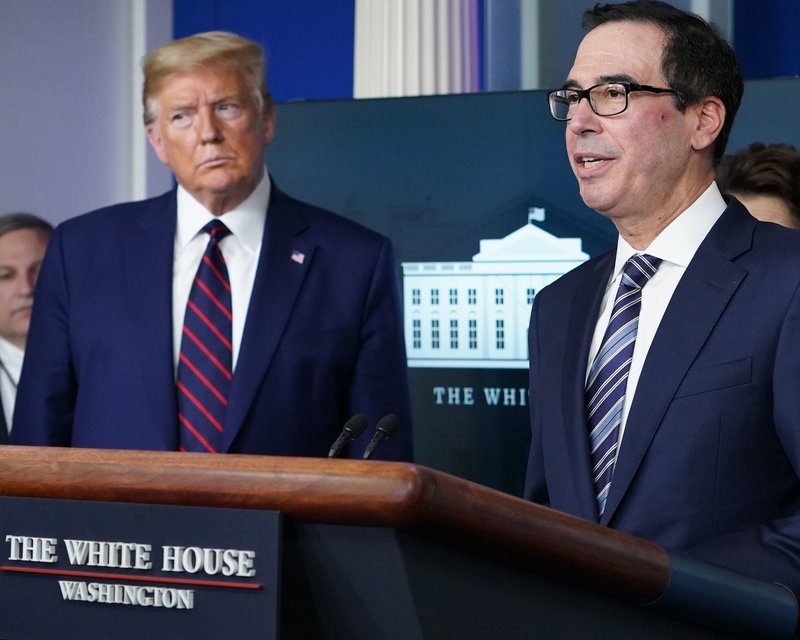Donald Trump listens as Treasury Secretary Steven Mnuchin speaks at a White House briefing on Coronavirus
Checked by medical advisors, Donald Trump has stepped back from the lifting of social distancing guidelines over the spread of Coronavirus.
For the second time in less than three weeks, Trump retreated from a declared date for the removal of the Administration’s guidelines, which were issued on March 16. They include the closure of schools, restaurants, and bars; suspension of public events; and limits on gatherings to no more than 10 people.
With his priority on a stock market recovery and his re-election, Trump contradicted the medical advice on March 22, saying the US would “reopen” by Easter, April 12. He was forced to set this aside as the US death rate soared to almost 2,000 per day.
In recent days, Trump has been pushing for a May 1 lifting of the guidelines. He said on Thursday, “Hopefully, we’re going to be opening up — you could call it opening — very, very, very, very soon, I hope.”
But the latest model of the death toll set out the stark outcome. While the projected rate has been reduced to about 60,000 by August if social distancing is maintained, the casualties will rise to 300,000 if it is halted.
If stay-at-home guidelines are lifted, the toll could be 200,000, despite school closures until summer, 25% of Americans working form home, and some social distancing measures.
Christopher Murray, the director of the Institute for Health Metrics and Evaluation whose forecasts have informed the White House, summarized, “It’s enough to say that if we were to stop at the national level May 1, we’re seeing a return to almost where we are now sometime in July.”
Trump tried to cover his retreat on Friday by portraying himself as America’s essential leader, setting aside his Coronavirus denial and mismanagement that escalated the crisis:
I’m going to have to make a decision, and I only hope to God that it’s the right decision,.But I would say without question it’s the biggest decision I’ve ever had to make.
He said, “We’re not doing anything until we know this country is going to be healthy. We don’t want to go back and start doing it over again.”
Yet Trump could not entirely release his priority of removing the guidelines: “You know what? Staying at home leads to death also. It’s very traumatic for the country.”
All but five US states have stay-at-home orders. Trump has refused to issue a national order.
Governors still retain the authority on when to lift orders, but Trump’s command could give some — such as Florida’s Ron de Santis, who reluctantly and belatedly closed down beaches and businesses — the political cover for a quick removal.
“Five administration officials” put out the message that it is “highly unlikely” that Trump will extend the social distancing guidelines beyond April 30. They said he is likely to announce a lifting of some measures rather than a withdrawal of all of them.
State and Local Efforts Amid Administration Failure
The US death toll from the virus is now 18,777. For the third day in a row, it rose by almost 2,000 on Friday.
More than half of the deaths are in New York (7,887) and New Jersey (1,932). Michigan is third with 1,276.
New York Governor Andrew Cuomo said this week that, while deaths continue to rise in the state, the increase in cases is slowing because of social distancing. On Friday, admissions to intensive care units declined for the first time.
Cuomo emphasized that easing of restrictions requires testing of millions of workers.
But the Trump Administration has failed throughout the crisis to provide the testing which could have contained the spread of the virus.
Rejecting use of a World Health Organization test, the Administration counted on the Centers for Disease Control to quickly provide an alternative. However, the CDC test proved faulty in February, and the Federal Government offered no coordination for states as Trump said the virus would soon be “close to zero”.
Dr Deborah Birx, the White House Coronavirus coordinator, said on Friday that the trend in US deaths and cases could not be adequately evaluated without testing:
As encouraging as they [the latest case figures] are, we have not reached the peak.
With the failure of the Trump Administration to coordinate effective action, State and local leaders are trying to establish the system of mitigation which could eventually lead to an easing of social distancing.
Massachusetts has begun the hiring and training of a contact tracing force. Utah has reassigned government employees to increase tracing capacity, and San Francisco, California is pursuing a 150-person contact tracing team using city librarians, university staff, and medical students.

